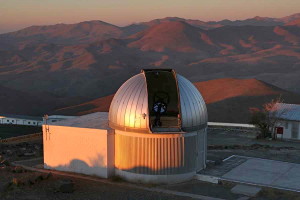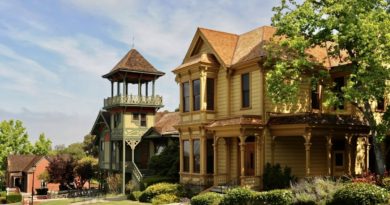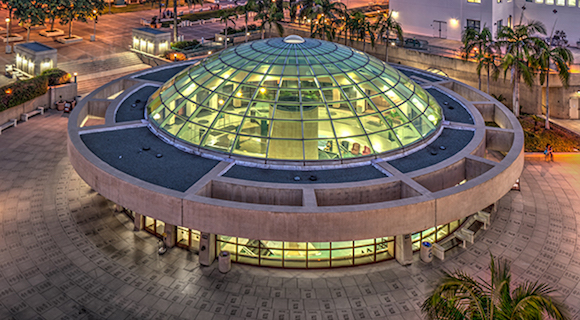Daily Business Report-May 3, 2016
Artist’s impression of the system as seen from the surface of the outer planet. Though nine times smaller than the Sun, the star looks significantly larger in the sky because the planet is 8 to 20 times closer to it than the Earth is to the Sun. (UCSD)
Three Earth-Sized Planets
Found Orbiting a Tiny Star
By Kim McDonald | UC San Diego News Center
An international team of astronomers, including UC San Diego astrophysicists, has discovered three Earth-sized planets orbiting near the “habitable zone” of an ultracool dwarf star, the first planets ever discovered around such a tiny and dim star.
The discovery is detailed in a paper published this week in the journal Nature. The planets are so close to Earth — only 40 light years away — that astronomers should eventually be able to study in greater detail the composition of each of the planets and their atmospheres as well as look for chemical signals of life.
“The kind of planets we’ve found are very exciting from the perspective of searching for life in the universe beyond Earth,” said Adam Burgasser, a professor of physics at UC San Diego’s Center for Astrophysics and Space Sciences and a key participant of the international team.
Using a telescope called TRAPPIST (TRAnsiting Planets and PlanetesImals Small Telescope) at the La Silla Observatory in Chile, the astronomers traced the star’s light moment-to-moment over the course of 62 nights last September through December. When the international team, led by Michaël Gillon of the University of Liège, Belgium, analyzed changes in brightness of the starlight, they saw periodic dips as three planets traverse its face casting shadows.

The TRAPPIST telescope of the University of Liege, located at the La Silla European Southern Observatory in Chile, was used to make the discovery.
Follow-up observations with larger telescopes indicated that the planets have sizes very similar to that of Earth. Two of the planets have orbital periods of about 1.5 days and 2.4 days respectively, and the third planet has a less well determined period in the range 4.5 to 73 days.
“With such short orbital periods, the planets are between 20 and 100 times closer to their star than the Earth to the Sun,” said Gillon. “The structure of this planetary system is much more similar in scale to the system of Jupiter’s moons than to that of the Solar System.”
The team determined that the three planets are roughly Earth-sized and may be rocky, although additional measurements of their masses will be needed to determine their compositions. More importantly, although they orbit very close to their host dwarf star, the inner two planets only receive four times and twice, respectively, the amount of radiation received by the Earth, because their star is much fainter than the Sun. That puts them just inside the habitable zone for this system, an orbital ring of distances at which surface water is likely to be liquid and life as we know it most likely. It is still possible that they possess habitable regions on their surfaces, although complexities such as their clouds, and atmospheres — if they have atmospheres — make it hard to predict whether surface conditions are really suitable for life. The third, outer, planet’s orbit is not yet well known, but it probably receives less radiation than the Earth does, but maybe still enough to lie within the habitable zone.
The astronomers said the two planets closest to the star are likely to be tidally locked, with one face always toward the star and the other always dark. That could limit circulation of water and atmosphere, which might become trapped on the cold, dark side, although the astronomers speculate that life could exist in the perpetual dawn at the day side’s western edge. On the other hand, tidal forces could keep the planet surface warm even on the dark side, but it could also drive vigorous geothermal activity that make the surfaces unstable.
“Fortunately, we may be able to answer these questions in the near future, as the geometry of the system makes it likely that we will be able to detect the atmospheric gases of these planets in the next decade with the launch of the James Webb Space Telescope,” Burgasser said. “This facility will allow us to search for biogenic gases–oxygen or methane for example–that would firmly indicate the presence of life, or search for other gas species that would tell us about the planets’ compositions, geothermal activity and evolutionary history.”
The star the planets orbit — called “TRAPPIST-1”– is cool, red, dim and so small it is invisible to most telescopes. Just a little larger than Jupiter in diameter, TRAPPIST-1 is about half the temperature of the Sun, a tenth of the size and almost 2,000 times fainter. Most of what astronomers know about it comes from observations in the infrared, the same kind of invisible light that remote controllers emit.
“While such a ‘cold’ star might sound exotic, many, if not most, of the stars in our Milky Way Galaxy are of this cool, red, small and dim variety,” Burgasser said. “If Earth-like planets around these stars turn out to be common, there may be many more habitable planets out there than current estimates predict.”
Although astronomers who hunt for exoplanets are eager for the deployment of the James Webb Space Telescope, now slated to launch in 2018, the discovery team is already expanding observations of these planets’ orbits and their magnetic interactions with the star.
“We expect intense scrutiny of this system by our colleagues, given its remarkable properties,” said Burgasser.
Besides Gillon and Burgasser, the international team involved other astronomers at UC San Diego and the University of Liège as well as researchers at MIT; NASA’s Johnson Space Center in Houston; Cavendish Laboratory in Cambridge, England; and the Indian Institute of Astrophysics in Bangalore, India.
______________________________________________

Philanthropists’ $11.8 Million Grant
Will Create Senior Emergency Care Unit
Local philanthropists Gary and Mary West have provided $11.8 million to the University of California San Diego to create a state-of-the-art senior emergency care unit to be housed within the Emergency Department at the future Jacobs Medical Center.
The Gary and Mary West Senior Emergency Care Unit will enhance care for older adults and enable a multi-year medical research initiative in partnership with the West Health Institute to support their mission of making successful aging a reality for seniors in San Diego and the nation. In recognition of the West’s support, the broader Emergency Department will also be named the Gary and Mary West Emergency Department at UC San Diego Health
Their support includes a $6.3 million philanthropic capital grant from the Gary and Mary West Foundation to create the Gary and Mary West Senior Emergency Care Unit, the first-of-its-kind in San Diego. An additional $5.5 million in planned research funding from the West Health Institute will be used to conduct multi-year medical research for developing, evaluating and disseminating innovative care approaches for geriatric patients.
“This significant combined philanthropic and research support will help UC San Diego Health fulfill its vision to offer a collaborative, interdisciplinary approach to caring for truly vulnerable members of our community,” said UC San Diego Chancellor Pradeep K. Khosla. “The Wests’ support will spur novel clinical care, research and teaching at UC San Diego, the region’s only academic health institution.”
Thanks to Gary and Mary West, UC San Diego Health in La Jolla will later this year offer enhanced emergency services designed to meet the unique needs of seniors. The services will focus on geriatric medicine, acute care screening, urgent care, case management, and social and psychiatric care. With a focus on fostering successful aging, the department will also facilitate home- and community-based care options when possible.

Symphony Towers Receives New Digital
Monitor Showing Environmental Performance
The Irvine Company’s Symphony Towers in Downtown San Diego has become the first California office building to qualify for a Leadership in Energy and Environmental Design (LEED) Dynamic Plaque as part of its recertification.
The plaque monitors a building’s environmental performance in five categories: energy, water, waste, transportation and human experience — and provides a continually updated score.
The U.S. Green Building Council also upgraded the office tower’s certification from silver to gold.
“The LEED Dynamic Plaque introduces an ongoing performance element to the LEED certification process and holds us accountable throughout the year,” said Christopher Popma, vice president of operations for Irvine Company Office Properties. “We always have been a pioneer in sustainable development and our goal is to provide environmentally healthy, high performance workplace communities, where our customers and their employees can flourish.”
The LEED rating system is the most widely used green building rating system in the world. Its new Dynamic Plaque is designed to enable building owners to see trends, and to improve building operations to save money, resources and make building occupants more comfortable.
Irvine Company intends to use the new LEED Dynamic Plaque platform in all of its LEED-certified office buildings in the coming years.
SDX’s Interactive Day
To Draw Digital Leaders

More than 1,200 people are expected to attend the 12th annual Interactive Day San Diego on Friday at the Hilton Bayfront in Downtown San Diego. The day-long conference, featuring more than 40 speakers and a digital marketing certification course, is regarded as the premier digital marketing and ad technology conference on the West Coast.
The event is presented by SDX, formerly the San Diego Ad Club.
Morgan Spurlock, founder of New York-based Warrior Poets, will be the closing keynote speaker. His speech will focus on branded storytelling as it relates to the future of digital experiences of all kinds.
Spurlock was an Academy Award nominee for best feature documentary for his first film, “Super Size Me.” His other projects have included Showtime’s “7 Deadly Sins” and the FX series “30 Days.” Spurlock also was the host of the CNN television series “Morgan Spurlock Inside Man.”
In addition to his film and television work, Spurlock has been on the forefront of digital content creation. His company led Hulu’s push into original programming with its first series, “A Day in the Life.”
Five tracks will be offered: data and analytics, design and inspiration, branding and marketing, content distribution and development and technology.
Admission prices are $449 for students and nonprofits, $499 for members of SDX and the American Advertising Federation, and $599 for nonmembers.
$17.9 Million Awarded to San Diego
Region to Address Homelessness
The U.S. Department of Housing and Urban Development has awarded $17,859,969 to the San Diego region to combat homelessness.
The funding commitment from HUD marks an increase of $1.69 million over last year’s award for the county.
Councilman Todd Gloria has served as the governance chair of the Regional Continuum of Care Council (RCCC), a planning body required by HUD that coordinates housing and services funding for homeless families and individuals in San Diego County. The RCCC develops the grant proposals for the region.
“San Diego’s nearly $18 million award affirms the work we are doing regionally to shift our system to a housing first approach with a focus on coordination and data-driven decision-making,” said Gloria. “These solutions are working to end homelessness around the country.
The awards include four new projects totaling nearly $2.9 million for the RCCC. These projects include a regional Collaborative Assessment and Housing Placement project and three new bonus projects, including Alpha Square, Alpha Rapid Rehousing, and the St. Vincent de Paul 2015 Bonus Project. Tier 1 awards were announced in early April with San Diego earning an allocation of $14.9 million.
San Diego ranks fourth nationwide in overall homelessness population but was 23rd in level of federal funding last year. Gloria echoed Congressman Scott Peters’ call for the antiquated formula for federal dollars for homeless issues to be reevaluated.



